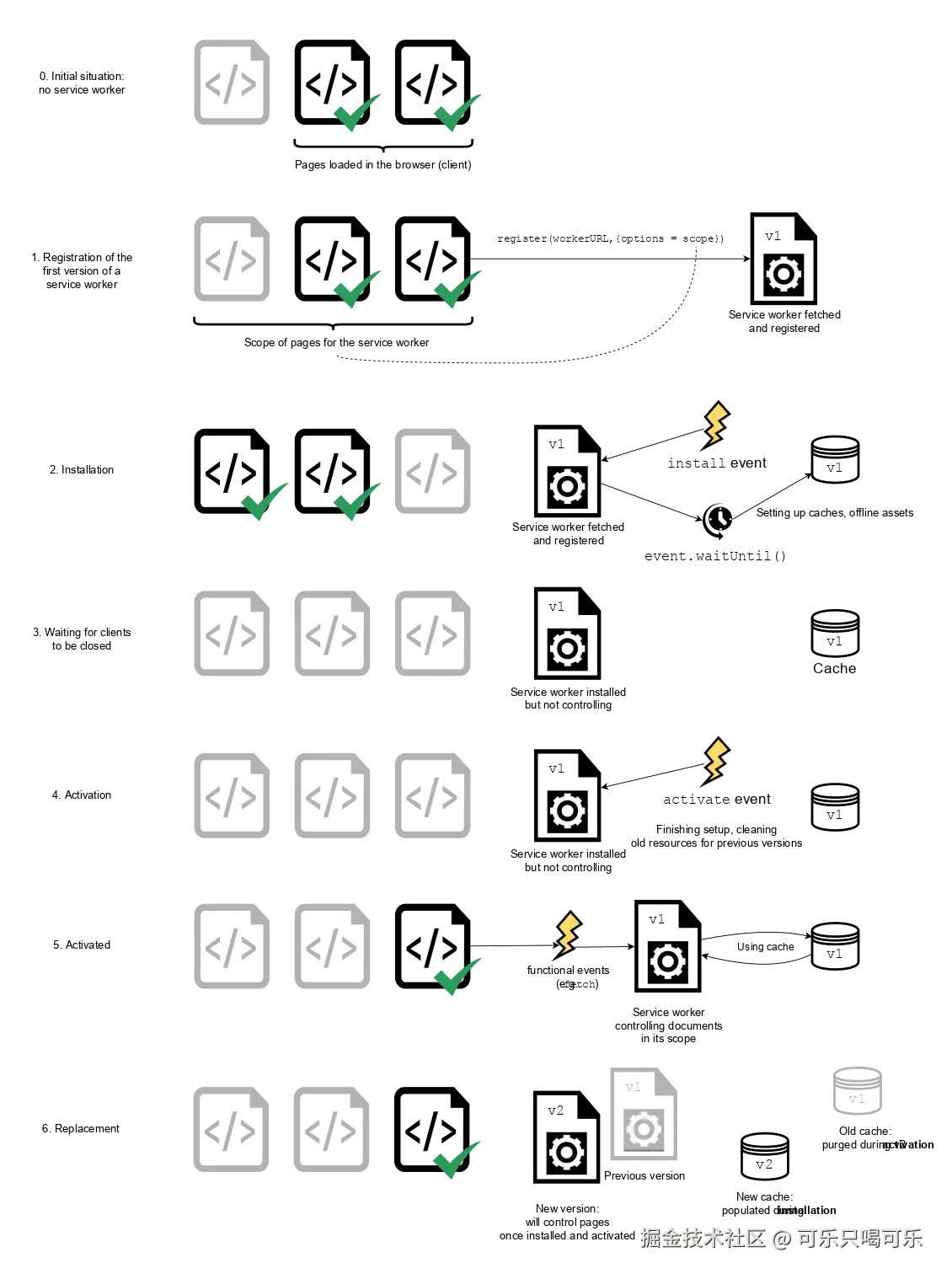前言
我经常看到有些博客站点拥有离线观看的功能,就算是没有网络,刷新页面依然可以获得数据。我对这一功能甚为好奇,了解后才发现这一技术是PWA。
何为PWA
PWA又为渐进式Web应用,在MDN上是这样说的, 渐进式 Web 应用(Progressive Web App,PWA)是一个使用 web 平台技术构建的应用程序,但它提供的用户体验就像一个特定平台的应用程序。它像网站一样,PWA 可以通过一个代码库在多个平台和设备上运行。它也像一个特定平台的应用程序一样,可以安装在设备上,可以离线和在后台运行,并且可以与设备和其他已安装的应用程序集成。
如何实现
构建一个PWA程序主要是用到service worker技术,这一项技术在现代浏览器中默认开启。
 以上是一张官方的图,讲解了
以上是一张官方的图,讲解了service worker的工作流程,简单来说就是注册程序 —> 安装程序 —> 激活程序 —> 获取数据 —> 版本更新后再次获取数据 。
注册程序
1if ("serviceWorker" in navigator) {
2 navigator.serviceWorker.register("/sw.js");
3}
安装程序
- 定义版本号
1const VERSION = "v1"
- 定义缓存名称
1const CACHE_NAME = `cache-${VERSION}`
- 确定需要缓存的数据
1const APP_STATIC_RESOURCES = [
2 "/",
3 "/favicon.svg",
4 "/mainfest.json",
5 "/offline",
6 "/sw.js"
7];
- 安装程序 在安装程序的时候,将静态资源进行缓存
1self.addEventListener("install", (event) => {
2 event.waitUntil(
3 (async () => {
4 const cache = await caches.open(CACHE_NAME);
5 cache.addAll(APP_STATIC_RESOURCES);
6 })()
7 );
8});
激活程序
在激活程序阶段,删除之前缓存的老数据
1self.addEventListener("activate", (event) => {
2 event.waitUntil(
3 (async () => {
4 const names = await caches.keys();
5 await Promise.all(
6 names.map((name) => {
7 if (name !== CACHE_NAME) {
8 return caches.delete(name);
9 }
10 })
11 );
12 await clients.claim();
13 })()
14 );
15});
获取缓存
进行网络拦截,当有网络的时候就直接获取网络发送的数据,当无网络的时候就获取缓存的数据
1self.addEventListener("fetch", (event) => {
2 const url = new URL(event.request.url);
3
4 if (url.protocol === 'chrome-extension:') {
5 return;
6 }
7
8 if (url.pathname.startsWith('/api')) {
9 return;
10 }
11
12 if (url.pathname.startsWith('/')) {
13
14 if (!navigator.onLine) {
15 event.respondWith(
16 caches.match(event.request).then((response) => {
17 return response || fetch(event.request).then((response) => {
18 return caches.open(CACHE_NAME).then((cache) => {
19 cache.put(event.request, response.clone());
20 return response;
21 });
22 }).catch(() => caches.match('/offline'));
23 })
24 );
25 } else {
26
27 event.respondWith(
28 fetch(event.request).then((response) => {
29 return caches.open(CACHE_NAME).then((cache) => {
30 cache.put(event.request, response.clone());
31 return response;
32 });
33 })
34 );
35 }
36
37
38 } else {
39 event.respondWith(
40 caches.match(event.request).then((response) => {
41 return response || fetch(event.request);
42 }).catch(() => caches.match('/offline'))
43 );
44 }
45});
加餐
缓存应用程序只是PWA技术的其中一个功能,PWA还可以进行该网页以exe的形式安装在电脑上,我觉得这个挺好玩的。
比如说我们可以在GitHub上看到这样一个标识,这就是一个可安装的PWA应用程序。

将PWA改造为一个可安装的应用程序员也很简单。我们只需要建一个mainfest.json文件,在这个文件里面配置相关的标题,图标这些,然后在head里面引入。
1<head>
2 <link rel="manifest" href="/mainfest.json" />
3</head>
mainfest.json里面的数据如下
1{
2 "name": "krismile🥤 Blog",
3 "short_name": "krismile🥤 Blog",
4 "description": "我的博客,记录一些技术与日常!",
5 "icons": [{
6 "src": "favicon.svg",
7 "sizes": "200x200",
8 "type": "image/svg+xml"
9 }],
10 "background_color": "#fff",
11 "theme_color": "#000",
12 "start_url": "/",
13 "display": "standalone",
14 "orientation": "portrait"
15}
总结
就这样我们就通过PWA技术实现了其中的网页的缓存以及安装,这一技术很适合在博客类的程序上使用,可以大大提升其体验程度,当然对于大多数的IAAS应用也是可以的。
个人笔记记录 2021 ~ 2025